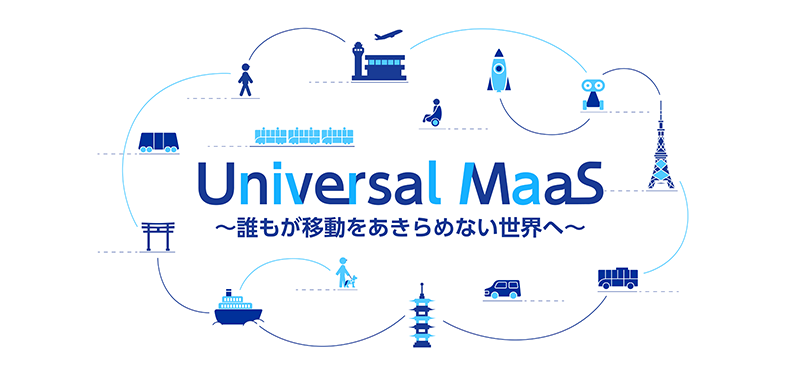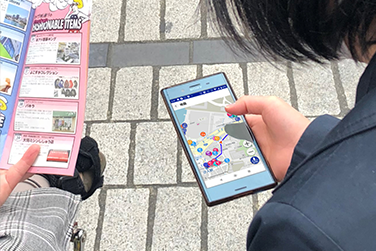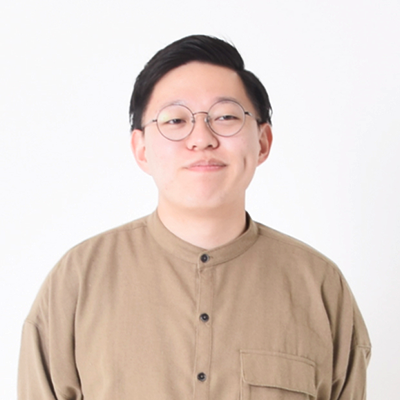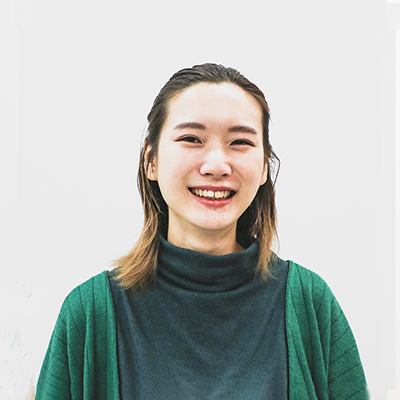UI Design for Universal MaaS App
Realizing A World Where No One Gives Up on Mobility
Publication date: March 29, 2021

Publication date: March 29, 2021
MaaS (Mobility as a Service) is defined as the integration of various transport services into a single mobility service that can be used on demand. Recently, MaaS often refers to seamless transportation services using ICT to integrate several transportation operators such as air, rail, and bus operators into one service. While existing transit apps provide travel information, what makes MaaS unique is that it also provides ability to make bookings and payments as a one-stop service. Currently, in Japan, various public and private operators are engaged in MaaS, and it is gaining attention as a next-generation transportation service. It is a service with promising potential for future development as connecting various transportation services into one service is said to have many benefits for both operators and users.
All Nippon Airways Co., Ltd. (ANA), Keikyu Corporation, Yokosuka City, and Yokohama National University are working together to develop "Universal MaaS: A World Where No One Gives Up on Mobility" (Universal MaaS). The service aims to provide comfortable and stress-free mobility for people who may hesitate to travel for various reasons (mobility-resistant persons). We held demonstration tests from December 1, 2020 to February 28, 2021 in Yokosuka City. We invited users to try out the app for the general public, the Universal Outing App, developed under the Universal MaaS Concept.
 The project concept is "A World Where No One Gives Up on Mobility"
The project concept is "A World Where No One Gives Up on Mobility"ANA asked Fujitsu Design Center to design the app, and Mr. Yuasa and Ms. Sakai proposed a user-experienced-based UI design. Subsequently, young designers from the same team, Mr. Iwai and Ms. Okabe, joined the project. Below, we explain the Universal MaaS app’s UI design, which combines a universal design perspective with MaaS.
The service concept of Universal MaaS is "A World Where No One Gives Up on Mobility." To bring this concept to life, we thought that in addition to functionality, it was crucial to focus on improving the quality of the mobility experience. In other words, making mobility fun. In app development, there’s often a tendency to focus on enhancing functionality. However, for UI/UX design, which takes user perspective into account, it's vital to consider the experience, whether the app is truly useful for users and makes their experience more enjoyable.
Mr. Osawa, the project leader from ANA, recalls how he came to request the Fujitsu Design Center to develop UI/UX for the app.
"We held a workshop before we asked Fujitsu to develop the app’s UI/UX. First, we shared our own personas and attributes and started the workshop with a mutual understanding of what obstacles we face with mobility. From this experience, I noticed that in the world of mobility, the definitions of a "disabled person" and a "healthy person" are not clear.
There are situations where anyone hesitates to travel (becomes mobility resistant), and I became convinced that removing these hesitations would lead to new motivations for mobility. Also, in discussions with Fujitsu, I noticed that, it was also crucial for individuals to create their own tailored mobility experience. As a result, we decided to try to build an app that would embody this concept."
Mr. Iwai explains that for this Universal App, which is aimed at individuals with physical disabilities, there were several considerations they took into account.
"Specifically, we designed the app with color universal design in mind and chose colors for elements such as buttons and text that had a high degree of contrast with the background. Even in standard apps, appropriate space is left between buttons, but for this universal app, we put more space between the buttons to prevent mistakes when pressing them. This is because, even with wheelchair users, there are individuals with disabilities in areas other than their legs, such as their fingers, arms, or upper body, which makes complex screen operations challenging. Also, we heard from ANA that some users have difficulty using two fingers for the pinch-in and pinch-out functions to zoom in or out. So, we added zoom-in (+) and zoom-out (-) buttons to the app.
In terms of functions, users can customize and save a chosen route among several options displayed in the search results. This feature allows users to create "My Personal Travel Guide" within the app, making mobility more enjoyable. Currently, the app contains a route saving function and a function that links information about the user's attributes and location with the service-provider's "Universal Support App." Moreover, we are considering including communication functions between users and service providers in the future.
 Features of the Universal App
Features of the Universal AppFrom the perspective of universal design, the app also contains a function that centralizes and displays information on transportation and related arrangements in one place in cases where users transfer between multiple public transportation services. Centralizing information that users typically had to collect on their own is likely to greatly reduce not only time and effort but also stress.
On the first day of the demonstration test, Ms. Okabe and Mr. Iwai attended the "WheeLog! Urban Walking Event in Yokosuka."and observed the users as they used the app. Ms. Okabe shared her comments about the event with us.
"Honestly, we didn’t receive much feedback regarding the design. But I think this lack of specific feedback is probably because users were able to use the app easily. That being said, I was happy that some of the users commented on the functional aspects of the app, like the ease of searching, the display of recommended routes, and the listing of necessary information. They found these features convenient and were encouraged to try using the app."
In the urban walking event, held on the first day of the demonstration test, December 1, 2020, participants were divided into six groups of five to six people, with one wheelchair user per group. Participants who normally do not use wheelchairs also took turns using the wheelchairs, allowing them to experience the urban walk from both perspectives of wheelchair users and non-wheelchair users. While moving through the city using pedestrian routes that included stone-paved streets, participants used the WheeLog! App to collect and post wheelchair travel logs and information about barrier-free spots. The information posted is immediately incorporated into the Universal Outing App that we created, and the participants were able to experience the joy of knowing that, thanks to their actions, they expanded the areas where wheelchair users can go out with confidence.


Mr. Iwai and Ms. Okabe also participated in the event and seemed to have a renewed sense of the necessity and difficulty of universal design. It was the first time Mr. Iwai used a wheelchair, stating, "I had no idea it was this hard to move around using a wheelchair. I realized that small steps on sidewalks, gentle slopes, and cobblestones, things I normally wouldn't notice, are significant obstacles for wheelchair users. I was also surprised at how often I ran into them. There are small obstacles all over the city, and they really tire you out. So, I was able to get a keen understanding of why wheelchair users hesitate to go outside or travel. Actually trying to get around using a wheelchair has given me a deeper understanding and a clearer perspective of disabilities."
Ms. Okabe also shared her thoughts on the difficulty of universal design. "For example, textured tiles are used by visually impaired people, but these can become an obstacle to wheelchair users. Similarly, barrier-free measures for wheelchair users may become obstacles for people with other disabilities. Honestly, catering to all people's needs is difficult. That being said, I feel that we must continue considering universal design from various perspectives.
In the process of having ANA review the app's UI design, we started to discuss the fact that we want to help a wide range of people, not just wheelchair users. To reiterate, not all wheelchair users' disabilities are the same, and similarly, there are various people in the world who require universal design. It won't be easy, but we will listen to users and create experiences that meet their needs. Being involved in this line of work has led me to increasingly think this way."
In this project, before Mr. Iwai and Ms. Okabe began working on UI design, Mr. Yuasa and Ms. Sakai from the same team at the Design Center, made a proposal to ANA. The two young employees were responsible for UI design, while Mr. Yuasa and Ms. Sakai oversaw the project as advisers.
Mr. Iwai joined the project immediately after entering Fujitsu, and it seems he gained various insights into how design is done at Fujitsu. "Mr. Yuasa and Ms. Sakai deeply consider whether a design truly benefits the individual. This point was often brought up even when reviewing the app's UI design within the team, and I realized that I often lose sight of the original purpose of why and who we are designing the app for. I was impressed by the team's people-first focus and their consideration of the user. I thought their constant iteration on this process was wonderful."
Ms. Okabe is a designer who joined Fujitsu as a new graduate last spring. She commented on her workplace, saying, "Although I've just started in my career, there are many different types of designers here, and it is a great place to think about what kind of designer I want to be. In the Universal MaaS project, Mr. Yuasa and Ms. Sakai designed various things in addition to app UI, such as the ideal form of the project as a business and how to communicate with ANA. I also want to be a designer who constantly considers the basics from various perspectives.
Soichiro Iwai and Moeko Okabe
Design Center
 Soichiro Iwai
Soichiro Iwai Moeko Okabe
Moeko Okabe